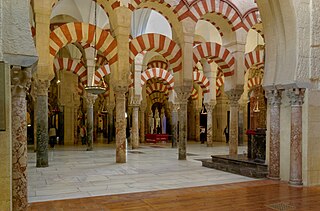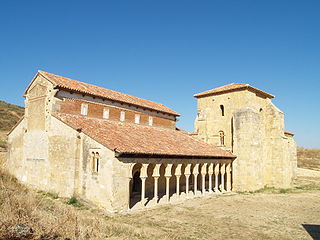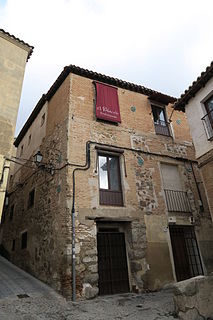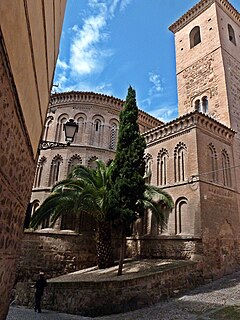
The Visigoths entered Hispania in 415, and they rose to be the dominant people there until the Moorish invasion of 711 brought their kingdom to an end.

Moorish architecture is the articulated Islamic architecture of North Africa and parts of Spain and Portugal, where the Andalusians (Moors) were dominant between 711 and 1492. The best surviving examples in Iberia are La Mezquita in Córdoba and the Alhambra palace in Granada, as well as the Giralda in Seville (1184). Other notable examples in Iberia include the ruined palace city of Medina Azahara (936–1010), the church San Cristo de la Luz in Toledo, the Aljafería in Saragossa and baths at for example Ronda and Alhama de Granada.

San Pedro de la Nave is an Early Medieval church in the town of Campillo, in the municipal unit of San Pedro de la Nave-Almendra, in the province of Zamora, Spain. It was declared a national monument on April 22, 1912.

The Mosque of Cristo de la Luz is a former mosque in Toledo, Spain. It is the one of the ten that existed in the city during the Moorish period. The edifice was then known as Mezquita Bab-al-Mardum, deriving its name from the city gate Bab al-Mardum. It is located near the Puerta del Sol, in an area of the city once called Medina where wealthy Muslims used to live.

The designation artede (la) repoblación was first proposed by José Camón Aznar in 1949 to replace the term Mozarabic as applied to certain works of architecture from the Christian kingdoms of northern Spain between the end of the 9th and beginning of the 11th centuries. Camón argued that these buildings were related stylistically to the architecture of Asturias and owed little to Andalusian styles. Moreover, since they were built by Christians living under Christian rule, neither were they Mozarabic.
Santa María de Melque is a church in the border municipality of San Martín de Montalbán in the province of Toledo, 30 km south of the capital, and equidistant from the towns of La Puebla de Montalbán and Gálvez, between the brook Ripas and the river Torcón, a tributary of the river Tagus.

San Miguel de Escalada is a monastery in the province of León, Spain, located 10 km from the Way of St. James pilgrimage route to Santiago de Compostela. The building is an example of Mozarabic art and architecture or Repoblación art and architecture.

San Sebastian is one of the oldest churches of Toledo, Spain. It once was close to the former city gate called "Bab-al-Dabbagin" also known by its Spanish name as "Puerta de los Curtidores". Archeological research shows that it was originally built as a mosque in the 10th century, and enlarged in the 11th century. The mosque was called Al-Dabbagin., sometimes transliterated as Adabaquín. Some time after 1085 it became the church of one of the six Toledan parishes of the Mozarabic rite. The architectural reconstruction dates from the late 12th or 13th century.

The Mezquita de las Tornerías is a Moorish former mosque in Toledo. It was built in the middle of the 11th century, built on a foundations of Roman architecture, located in the old Muslim neighborhood Arrabal de Francos. Currently it houses the "Center Foundation of Promotion of the Crafts", that can be visited and attend temporary exhibitions. The building continued maintaining the Islam in Spain, even well beyond the reconquista of the city by the Christian troops of Alfonso VI of León and Castile in 1085, until the period of 1498 - 1505 when was desacralizated by the Catholic Monarchs. Already as a building for civil use, it goes through various vicissitudes, first as an inn in 1505 and then as the headquarters of different businesses and small factories or as a simple home. Its history is lost until the late 19th century, where historians investigate its origins didn't know if it was a synagogue or a mosque. After the studies, the 15 March 1905 was officially communicated to the Real Academia de la Historia the finding of an Arab mosque in the street of the Tornerías.

The Mezquita-Iglesia de El Salvador is a church in Toledo, Spain completed in 1159.

The Iglesia de San Román is a church in Toledo. The church was built in the Mudéjar style in the 13th century. In this site there was an old Visigothic structure and probably an ancient Roman building. It is currently the headquarters of the Museum of the Councils and Visigothic Culture.

The Church of San Nicolás also known as the church of Church of San Nicolas de Bari, or the Church of San Nicolas de los Servitas, is Catholic parish church in central Madrid, Spain.

The Iglesia de Santo Tomé is a church located in the historical center of the city of Toledo (Spain), and was founded after the reconquest of this city by King Alfonso VI of León. It appears quoted in the 12th century, as constructed on the site of an old mosque of the 11th century. This mosque, together with other mosques in the city, were used as Christian churches without major changes, since in the taking of the city there was no destruction of buildings.

The Iglesia de las Santas Justa y Rufina is one of the so-called Mozarabic parish churches of Toledo, whose existence has been documented since 1156. However, certain material remains reveal the existence in this place of an Islamic construction, which would undoubtedly have to be identified with a mosque. Until very recently, the only testimony of the existence of an Islamic construction consisted of a fragment of arch that, on a Visigothic pilaster, was embedded in the northwest facade of the temple. The reuse of a piece from previous period, combined with the characteristics of the cutting of the arch, allow them to think of an Islamic work dating around 10th century.

The so-called Templar House in Toledo, in Castile-La Mancha, Spain, was built and decorated between the years 1085 and 1114, belonging to this period the general structure, typically Al-Andalusian, supported by the vaults of the basement and organized around the courtyard. The strict contemporaneousness existing between this monument of Toledo, the Aljafería palace of Zaragoza (1046–1082), and the roofing of the church of San Millán of Segovia is shown by the fact that the large majority of the construction elements for the roofs and ornamental designs are practically the same on all three buildings.

The Iglesia de San Miguel el Alto is a Mudéjar church located in Toledo. It is one of the old Latin parishes of the city of Toledo. Apparently, this church was in relation to the Knights Templar being founded by them, serving as chapel or oratory of the inn for the knights of this order.

The Iglesia de San Bartolomé is a church located in the city of Toledo, in Castile-La Mancha, Spain.

The Iglesia de Santa Leocadia is a church located in Toledo, in Castile-La Mancha, Spain. The Toledan tradition maintains that this church is built on the site of the house where Saint Leocadia of Toledo was born, to which would belong a small underground room, where it is affirmed that it made prayer. This cave corresponds to the crypt located next to the right pillar of the presbytery, and is covered with a plaster crossery vault, which can be dated in the first half of the 16th century. In the tower and in the facade of the church are preserved, embedded, some fragments of Visigothic style's reliefs.

The Iglesia de los Santos Justo y Pastor, popularly known as Iglesia de San Justo, is a church located in the city of Toledo. It was founded after the city was taken by King Alfonso VI of León and Castile in the 13th century. The city underwent transformations between the 14th and 18th centuries. This is a religious temple under the invocation of the holy children Justus and Pastor.

The Colegio de Nuestra Señora de los Infantes is a college of the city of Toledo was founded by the Cardinal Silíceo in the 16th century. The building, already completed in 1559, was not constructed as a new plant, but was the result of the remodeling of an existing property. The plant, totally, irregular, is imposed by the adjacent streets, which make the College an exempt building.



























